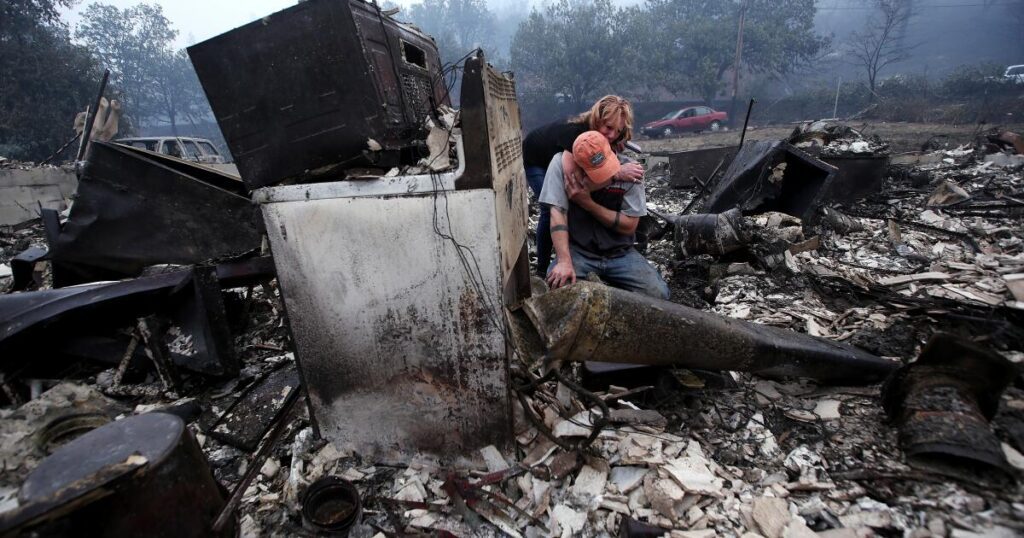Climate change and extreme weather have contributed to catastrophic wildfires that have destroyed thousands of homes in California in recent years — and an insurance crisis that could lead to the largest set of regulatory changes since Proposition 103 passed in 1988.
Insurers have pulled out of the homeowners' market, sparking a flurry of activity in Sacramento aimed at making coverage available and affordable for at-risk residents in places like the Santa Monica Mountains and Malibu. Here's what's happening — and some steps homeowners can take now to soften the blow.
How big of a deal is this really?
The crisis reached new heights last week when leading insurer State Farm General announced it would not renew 72,000 landlord insurance policies statewide, joining Farmers, Allstate and other companies in either not writing or limiting new policies or tightening underwriting standards. The companies blame wildfires, inflation that has pushed up reconstruction costs, high rates for the reinsurance they buy to shore up their balance sheets and protect themselves from disasters, as well as outdated state regulations — claims that some consumer advocates dispute.
How does this decline affect homeowners?
“It's really a tale of two states,” said Michael Soler, a spokesman for the state Department of Insurance. If you are a landlord, for example, in the San Fernando Valley, you likely still have several insurance companies from which you can purchase a policy. But if you live in what's called the “wild urban interface” — a hillside, valley or other neighborhood close to nature — your options are likely limited and expensive, if you can even get an insurance policy. This has forced thousands of homeowners to join the California FAIR Plan, an industry-funded insurer of last resort that offers policies with limited coverage.
What is happening in Sacramento to solve this problem?
There was an attempt last year to reach a solution in the Legislature but it collapsed, prompting Insurance Commissioner Ricardo Lara to announce in September a package of executive actions called the Sustainable Insurance Strategy to reform the market by the end of this year, while getting buy-in from insurers. He got political support for the move from Gov. Gavin Newsom, who issued an executive order requiring Lara to take “swift regulatory action,” citing how the crisis could freeze much-needed new housing development.
So how will this plan help policy makers?
The commissioner wants to speed up the review process for insurers seeking to raise rates and allow them to factor expected costs of future catastrophes into their rates, as well as reinsurance costs that can be attributed to their California operations. The package also aims to return homeowners to the roles of commercial insurers and away from the FAIR plan, while improving the finances and coverage of the state's insurer of last resort. “We are at a major crossroads with regard to insurance,” Lara said, presenting the reform package.
Will the commissioner's reforms fly?
In February, Lara introduced draft regulations to streamline the rate approval process for insurers in the homeowners, auto and other markets, rules that were originally created under Proposition 103, the state's landmark insurance reform law. Lara says the regulations were drawn up in “the era of pagers and payphones” and do not accurately identify the materials and information needed for timely review.
Some in Sacramento thought the reforms were straightforward, but they faced stiff opposition from the Personal Insurance Association of California, a lobbying group for property and casualty insurers, which claims they confuse the process while giving regulators too much power. “They want to be able to say, ‘OK, if you want us to process your rate file, you have to give us all this other stuff,'” which has nothing to do with the calculation, said union president Rex Frazier.
His proposals to include so-called “catastrophe modeling” of future fires, storms and major insurance events, as well as the cost of reinsurance in insurance premiums, are controversial among consumer advocates.
Lara has not yet released draft proposals to incorporate insurers' reinsurance costs into rate reviews, nor precise proposals to move insurers back into areas at high wildfire risk and keep homeowners out of the FAIR plan. However, insurers and the administration came up with a general framework last year that requires them to write at least 85% of their statewide market share in those areas against his reforms. This means, for example, if an insurer had a 20% market share statewide, it would have to insure 17 out of 100 homes in such neighborhoods. The consumer watchdog says both catastrophe modeling and reinsurance considerations in setting rates have exacerbated problems in Florida's troubled homeowners insurance market, which has been hit by storm damage.
In the meantime, what can I do now if I live in neighborhoods at risk for wildfires?
In 2022, Lara released draft regulations now in effect that require insurers to offer discounts to homeowners who take steps to improve the ability of their homes and properties to withstand wildfires. They include installing a Class 1 fire-rated roof, better vents, enclosed eaves and defensible spaces, among 10 specific measures that qualify for a rebate. The department has already approved about 140 requests for insurance rates that take the program into account.
What if I have trouble getting a quote?
The Department of Insurance has a tool that allows homeowners to see which insurance companies write coverage in their neighborhoods. She will also speak directly with distressed homeowners who call 800-927-4357 or access the online chat through Insurance.ca.gov. The consumer group United Policyholders has worked extensively in this area and has its own online resource at uphelp.org.
